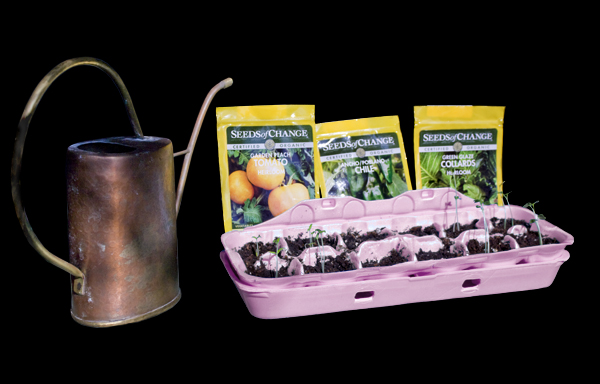 How to start heirloom veggies from seed
How to start heirloom veggies from seed
by Phil Forsyth
So you’ve been enjoying those orange, yellow, purple, green, striped, two-tone, cherry, plum, pear-shaped and downright unusual tomatoes from the farmer’s market. Then you get your hands on a seed catalog and the names call to you: Black From Tula, Golden Sunray, Aunt Ruby’s German Green. So how hard is it to grow these heirloom vegetables yourself?
First, you need a place to grow that has abundant sunlight, rich soil and easy access to water, such as a backyard, front yard, community garden, a patio, deck, rooftop or window box. Next, you need a good seed catalog with a wide selection to get your heirloom juices flowing. Try Seed Savers Exchange (seedsavers.org), Seeds of Change (seedsofchange.com) or Johnny’s Selected Seeds (johnnyseeds.com). Many of the seeds you get can be directly sown in the soil, but others, including tomatoes, peppers, eggplant, basil and most cabbage family crops, are best given a head start before transplanting into the garden. For those of us without access to a greenhouse, this can be accomplished cheaply and easily with a homemade egg carton seed tray.
Supplies you will need:
- heirloom seeds
- egg carton
- scissors
- potting soil
- plastic wrap
- pennies or pebbles
- pen or sewing machine
- watering can or spray bottle
Step by step instructions:
- Consult your seed pack, catalog or garden book to calculate when you need to get your seeds started. For warm season crops like tomatoes, this is six to eight weeks prior to planting (mid-May in Philly). Penn State Cooperative Extension’s Philadelphia planting calendar is a useful guide (philadelphia.extension.psu.edu/horticulture/plantingguide.html).
- Separate the top and bottom half of your egg carton with scissors.
- Put a few pennies or small pebbles in the top half of the carton to create space for drainage. If you’re using a paper egg carton, you’ll first want to lay down some plastic wrap as a liner.
- Use a needle or pen tip to poke several drainage holes into each cell of the egg carton bottom.
- Place the egg carton bottom into the top.
- Fill each cell with potting soil up to the dividers. Wet the potting soil prior to planting. The soil should be damp, not saturated.
- Plant two or three seeds per cell. Check your seed pack for proper depth—a general rule of thumb is twice the diameter of the seed.
- Cover your seed tray with plastic wrap to keep the moisture in. Place the seed tray somewhere out of direct sunlight and near a heat source. A soil temperature of at least 75 degrees is ideal for germination.
- Remove the plastic wrap after the seedlings emerge, usually within a week. Now you need to move the tray to your brightest window. If you don’t have a sunny window, you’re going to need grow lights.
- Water whenever your soil begins to dry, being careful not to oversaturate. A misting spray bottle works especially well. After a few days of growth, use scissors to snip out all but the largest seedling in each cell.
- Using a spoon and great care, transplant your seedlings to a larger container after two or three weeks. If you don’t have any 4-inch pots on hand, soda bottles can be cut off as a good substitute. (Remember the drainage holes!) Water the seedlings immediately after transplanting and keep them out of the sunlight for a couple days until they adjust.
- Bring them outside for a couple hours a day about a week before your target planting date to get them acclimated, then increase this time over the course of the week. This process is known as hardening off. For warm season crops, avoid temperatures under 50 degrees.
Now you’re ready to heirloom your garden and your kitchen! If you missed your seed start date this year, you can still get a pretty good selection of heirloom transplants from Greensgrow Farm (greensgrow.org) in Kensington. But remember, the only way to wow your neighbors with Green Zebra tomatoes, Tequila Sunrise peppers and Striped Toga eggplants is to start them yourself!


